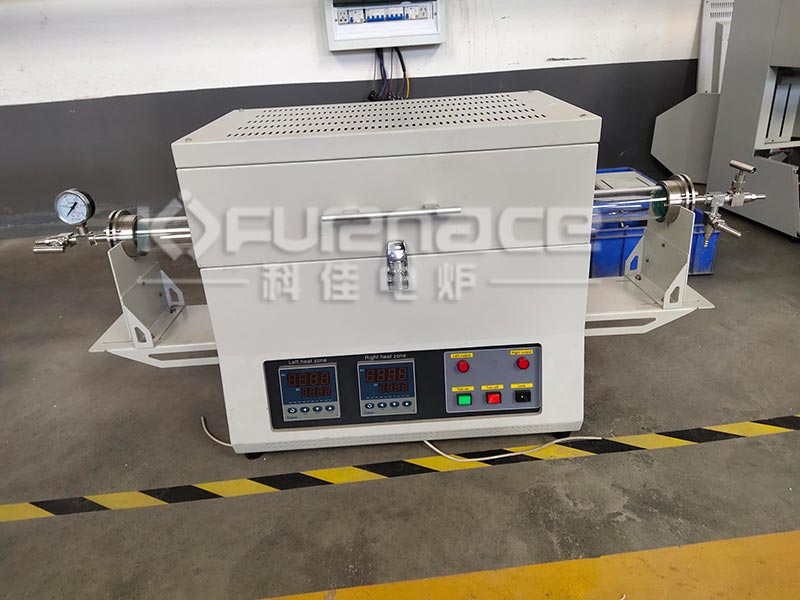Small scale experimental high-temperature tube furnace is a commonly used equipment for material high-temperature treatment in laboratories. It has the characteristics of precise temperature control, flexible atmosphere adjustment, and compact structure, and is suitable for scenarios such as material sintering, heat treatment, atmosphere control experiments, and sample high-temperature analysis. Let’s take a detailed look below!

Commonly used laboratory dual temperature zone tube furnace (click on the image to view product details)
1. Core advantages
Accurate temperature control
Equipped with a good temperature control system (such as PID controller), the temperature control accuracy can reach ± 1 ℃, meeting the needs of temperature sensitive material research and fine experiments.
The temperature range is wide, for example, some models can reach 1600 ℃, meeting the processing needs of high melting point materials such as special ceramics and refractory metals.
Flexible atmosphere adjustment
It can work under vacuum or specific atmospheres (such as nitrogen, argon, hydrogen) to prevent materials from being oxidized or contaminated by impurities at high temperatures.
Equipped with a gas flow control device to ensure the stability and consistency of the furnace atmosphere, and improve the reproducibility of experiments.
Compact structure, easy to operate
The tube furnace has a relatively compact structure and occupies a small area, making it suitable for scenarios where laboratory space is limited.
Microcomputer program control, user-friendly interface, supports temperature, rotation speed, atmosphere parameters and other settings, and can monitor the furnace status in real time.
High uniformity of heating
The heating element surrounds the furnace tube to ensure uniform temperature distribution and avoid local overheating or overcooling.
Some models have a rotation function, which can change the relative position between the material and the heat field, further improving heating uniformity.
2. Main application scenarios
Material sintering and high-temperature synthesis
Used for sintering new ceramic materials, metal oxides, and nanomaterials to form ideal crystal structures.
For example, in the growth process of semiconductor materials, controlling the atmosphere can reduce defects and improve crystal quality.
Heat treatment of metal samples
Annealing and quenching of metal samples to improve their mechanical properties.
In the field of microelectronics, the conductivity of semiconductor materials such as silicon wafers is adjusted through heat treatment.
Chemical reaction experiment
Perform chemical reactions in an inert gas or reducing gas environment (such as reactions under nitrogen or hydrogen atmosphere) to avoid external pollution.
Suitable for scenarios such as catalyst preparation and chemical reaction kinetics research.
High temperature analysis and testing
In atmospheric composition analysis, waste disposal, and catalyst performance research, samples are subjected to high-temperature treatment to analyze chemical composition or evaluate reaction products.
3. Key points for purchasing
Temperature range and heating element
Select the appropriate temperature range based on experimental requirements (such as 800 ℃, 1200 ℃, 1600 ℃, etc.).
Confirm the type of heating element (such as resistance wire, silicon carbide, MoSi ₂) to ensure it matches the experimental temperature.
Furnace tube size and volume
Choose the appropriate furnace tube diameter and volume based on the sample size to avoid wasting space or overloading.
For example, when processing powder samples, it is necessary to choose crucible loading and ensure that the furnace tube diameter matches the crucible.
Temperature zone design
Single temperature zone is suitable for simple experiments, while multiple temperature zones can meet the requirements of different temperature stages in complex material synthesis processes.
Multi temperature zone design can improve production efficiency and reduce equipment space and time occupation.
Functional scalability
Select additional functions based on experimental requirements, such as vacuum system, rotation function, special gas processing capability, etc.
For example, a rotary tube furnace can more uniformly heat treat powders and achieve powder coating effects.
Safety and sealing performance
Confirm that the equipment has safety protection measures such as over temperature alarm, overcurrent protection, and gas leakage detection.
Check the sealing design of the furnace door and furnace (such as silicone ring extrusion sealing) to ensure a stable atmosphere inside the furnace.

Experimental small rotary furnace (click on image to view product details)
4. Future Development Trends
intelligentization
Realize remote monitoring and control through IoT technology, and view real-time temperature changes inside the furnace.
Equipped with a good data collection and analysis system, it automatically records experimental data and supports big data analysis.
Energy saving
Use more efficient heating elements and insulation materials to reduce heat loss and improve energy efficiency.
Develop efficient and energy-saving tube furnace models to reduce operating costs.
miniaturization
Miniature tube furnaces are gradually emerging, suitable for small-scale experiments or fine sample processing.
Meet the laboratory’s requirements for equipment portability and space utilization.Click to learn more tube furnaces! Or click on online customer service to learn more about product information!